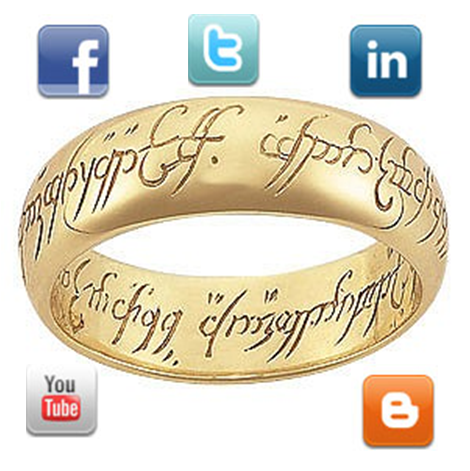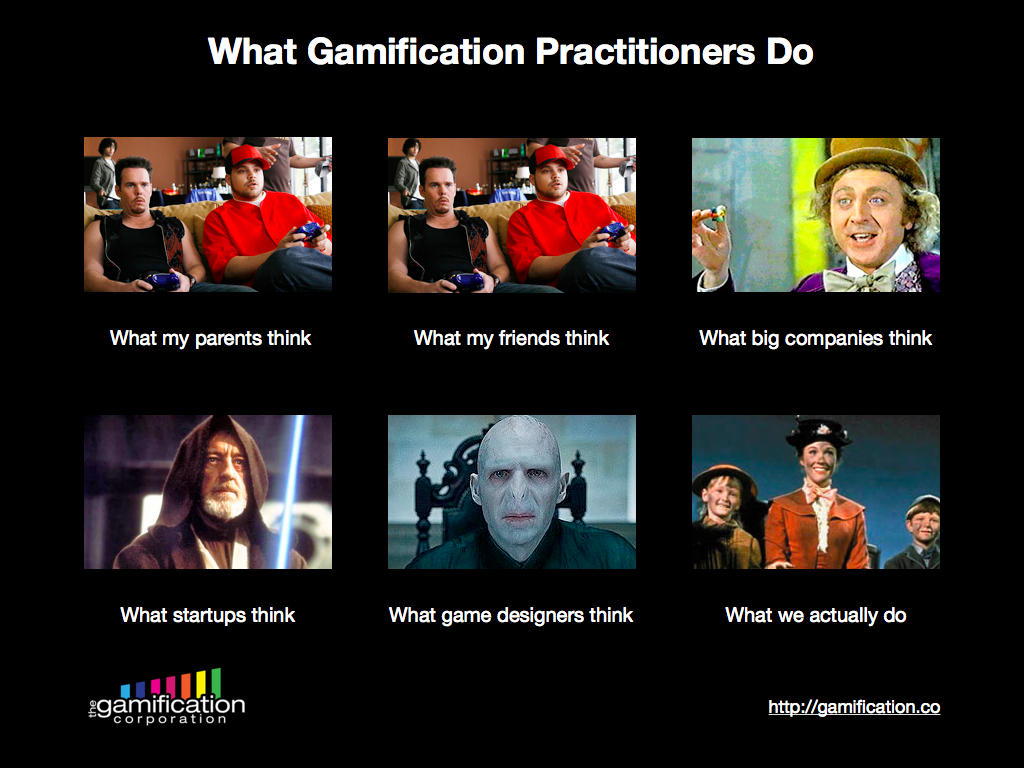#Gamification: One Ring to Rule Them All
Buzzword bingo and a fantasy literature reference all in one title? It’s almost too good to be true.
Thesis: Gamification is the Best Solution for Master User Identity Management
Gamification, and the creation of a separate and unique master user identity, provides the enterprise with the engine to connect a single individual’s entire portfolio of online identities.
Many marketers and professionals might follow such a bold statement with a series of assertions and opinions from gurus–I’m going to follow it with a problem statement and a Lord of the Rings analogy.

Master User Identity Management is a Serious Problem
The explosion of the web had an evolutionary impact on the way that an individual can interact with a brand. As a social media manager, and an optimist, I strongly believe this to be a lasting and positive impact. This positive evolution is not without its problems.

One of the largest of these problems involves Master User Identity Management. The term itself is long and unwieldy and simply aims to name a simple issue: there are too many of you. I use this not as the plural “you all” but as the singular and unique “you.” If your online self looks anything like me, you probably have at least:

Notice the issue? There are at least 5 different digital representations of me (or you). Luckily there is only one person with my name in the world–pretty cool–but what if my name was John Doe? Or Matt Smith? Good luck figuring out which of these pages actually belong to the digital me.
Gamification is the Solution to this Problem

“One Ring to rule them all, One Ring to find them,
One Ring to bring them all and in the darkness bind them”
What does a ring have to do with this?
Gamification is your one ring to rule them all. Ignore the fact that you have (at least) 5 different online identities–or the fact that every one of your audience members does too–and put your faith in the One Ring.
In Lord of the Rings, for the 4 of you that have not read/watched it, this one ring rules over all others. Even though many rings and power exist, the One Ring connects and commands them all. The main protagonist then spends hundreds of pages–or hours of film–trying to drop it in a volcano [Spoiler alert: he does].
Gamification Unites Your Identity Kingdom
A successful deployment of enterprise gamification builds a separate and unique identity for each of your online audience members. This is not another identity but rather the master identity itself. Think of this like a social security number–a single identity to which other identities and presences can be connected. Once this master identity is built, any and all other presences can and should be attached.
Deploying this One Ring must be done in stages, and carefully:
Stage 1: Select a Gamification Partner
My advice: select a vendor that appreciates the power of a fully-connected online ecosystem. Do not select one that has the best social strategy, the best community strategy, or the best web strategy–find the one that understands that, in the eyes of your audience, you are one entity.
My employer, EMC Corporation, will soon have news on this–but I will not be breaking it here. Sorry friends.
Stage 2: Establish the Master ID System
This ID can be based on almost any factor, from email to phone number to username, or it can be randomly generated and assigned. The most stable system creates this random identifier and then attaches all others to it.
Stage 3: Launch with Limited Connections
Launching enterprise gamification is not an easy endeavor. It requires careful calculation and attention and I strongly suggest focusing on one platform for program launch. At EMC, we made the choice to launch first on our external community platform. Part of this decision depends on the point of entry for your company’s program. If you happen to be a web manager, I’ll guess you would suggest a web-first strategy, and I wouldn’t blame you. I happen to be on the social and community team, so we plan to start there [More news soon friends].
Stage 4: Take over the World
I mentioned that I’m an optimist, didn’t I? Following a successful launch, the race is on to motivate users to connect this master identity to all other identities. Most users will not do so without proper motivation. As a gamificator, you hold the most powerful motivator of all: ego. Connecting the master identity to all of the auxiliary identities (Facebook, Twitter, etc.) allows a gamification manager to create a status that fully represents that users interaction.
Users Interact with One Brand–Give Them One Status-Based Identity to Go With It

Your online audience does not perceive 15 versions of your brand–they perceive one. It is time that the enterprise delivered a single status to pair with this perception–a status that rewards, recognizes, and motivates desired behaviors while also materially improving the user experience. Gamification is our weapon in this big data conflict–our One Ring to rule them all.
Closing Caveat: Gamification is About Balance
Well-executed gamification is a mutually beneficial relationship between the enterprise’s goals (increasing interaction and understanding behaviors) and the user’s desires (an improved user experience). If at any point the balance tips, the program fails. This post, however, aims to primarily address the enterprise perspective.
Stop Using The G Word: How To Successfully Pitch Gamification
A Rose by Any Other Name…
Gamification fascinates me–the concept and the word itself. Allow me to explain how you will successfully pitch gamification by never saying it again.
At first glance, the word suggests that we are turning everything into a game. The reverse is actually more accurate–everything was already a game and the process is just now catching up to the reality. The concept is beginning to spread across the world and Enterprise Gamification will be a major accelerator for the movement. In the meantime, we have to sacrifice The G Word to make the concept a reality.
The G Word Wears Sneakers to Work (& It Does Not Like Cubicles)
The G Word, as you might imagine, does not mesh with a Fortune 500 world full of suits, cubicles, and earnings reports. If the word were a person it would be an incredibly high performer–but it might also show up late wearing jeans and sneakers. In the Bay Area it would raise an eyebrow–on the East Coast security would not let it in the building.
I am being a bit facetious but my point is that an average executive has no idea what the term gamification means. The biggest problem with the term is that the only people who understand its meaning are the people that already understand the concept. If you find yourself as the person in an organization that is championing gamification this puts you in a precarious position.
Championing the Cause
If you are the champion of the gamification cause–if you are an innovator hoping to persuade the masses–you are left with one of two paths:
1. Explain gamification, the concept, by explaining away gamification, the word, in every conversation
2. Define your own relevant terminology that communicates the true power of the concept
Define Your Own Terminology
The section title may have given it away–but I tend to advocate taking the second path: defining your own terminology. In full disclosure, I work for EMC Corporation and I was the person that brought the gamification concept to the table. Many colleagues had discussed gamified systems but none had the right mix of timing and audience to drive real change. The key factors for innovation, however, surrounded us–a highly collaborative team, a group of intellectually-curious individuals always willing to listen to a new idea, and an executive willing to support us.
The G Word, however, was holding us back. As with most teams just beginning to explore the idea, the term either meant something different to everyone–or it meant nothing to anyone. My advice: forget The G Word and remove it from your vocabulary. For a time I pushed back. I thought “I know this concept better than anyone else and this is the term for that concept.” I was an idiot. If you’re the person fighting for gamification in your organization, you have to be prepared to fight for its potential, for its power, for its benefits–but not for the word itself.
Once you come to this point–once you are willing to give up The G Word–you are ready to begin communicating the value of such a program to your organization. In my case, our team fumbled with a few terms before settling on “Reward, Recognition, and Motivation Programs.”
Clunky? Yes. Verbose? Yes. Accurate? Absolutely.
Unify the Organization Behind a Vision
The vision you depict of a gamified future is far more powerful than The G Word in a vacuum. Gamification might confuse very bright individuals into thinking that you want to build a new game on your Facebook tab–or that you’re building a game to represent your brand. Based on my experience, you will be far more successful if you focus on and communicate what you can deliver for your brand–a program to redefine the way that you Reward, Recognize, and Motivate your audience members.
Ignore the Experts, Customize Your Message
Anyone reading this probably has a clear opinion on the split between researchers/consultants and practitioners–in any field. On a recent webinar, I submitted a question to a prominent researcher on gamification about the stigma of the term. To be frank, he responded like a jerk. He missed the fact that I was asking for his advice on how to pitch the term to a company full of well-meaning folks that, in most cases, have never heard the word gamification.
The last point I want to stress is this: tailor the message to your organization. In my case, Reward, Recognition, and Motivation Program works–in your organization it might not. For some The G Word might work, but for the rest of us we must look for a creative way to communicate the value of this powerful movement. It is your incredible privilege to bring this vision for a gamified future to your organization–make sure The G Word does not stop you from doing so.
Go forth and conquer, gamificators.
The New York Times Discovers Gamification – Now What?
Today is a very exciting day in the world of gamfication: The New York Times has discovered it. The incredibly quick progression from concept to widespread marketing tactic will now undoubtedly kick into overdrive.
A few thoughts in response to the NYT piece:
Early Adopters Gain a Bonus Point for Innovation

The early adopters of these tactics, especially those in the Business-to-Business space, not only gain the positive effects from their gamification programs but also the bonus bump from recognition. These businesses, and these marketing functions, will be seen as innovators.
User Rewards Must Be Real, Substantial, Valuable

Points, badges, and levels are all valuable rewards–but these programs must go beyond these to deliver more substantial rewards. These rewards can be monetary but businesses must also get creative and explore other options, including early access to products/services, VIP access to events, etc.
Data, Data, Data (and then Analytics)

As with any good marketing tool, we must identify what we want to know about our audience, and build the system to suit these needs. Every badge/point/level is a new level of insight and these must be analyzed to understand how the audience interacts with the brand, and how the brand can adjust to accommodate these patterns.
The New York Times: “You’ve Won a Badge (And Now We Know All About You)”
The source of the hubbub.
How Gaming Will Change Our World
Jane McGonigal, author of the fantastic Reality is Broken, delivered one of my favorite TED talks of all time.
Full post and comment thread here.






